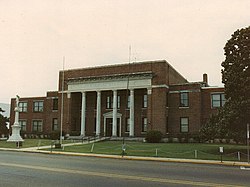Philadelphia, Mississippi
| Philadelphia, Mississippi | |
|---|---|
| City | |

Neshoba County courthouse in Philadelphia
|
|
 Location of Philadelphia, Mississippi |
|
| Location in the United States | |
| Coordinates: 32°46′27″N 89°6′46″W / 32.77417°N 89.11278°WCoordinates: 32°46′27″N 89°6′46″W / 32.77417°N 89.11278°W | |
| Country | United States |
| State | Mississippi |
| County | Neshoba |
| Government | |
| • Mayor | James Young |
| Area | |
| • Total | 10.6 sq mi (27.5 km2) |
| • Land | 10.6 sq mi (27.5 km2) |
| • Water | 0.0 sq mi (0.0 km2) |
| Elevation | 423 ft (129 m) |
| Population (2010) | |
| • Total | 7,477 |
| • Density | 688.1/sq mi (265.7/km2) |
| Time zone | Central (CST) (UTC-6) |
| • Summer (DST) | CDT (UTC-5) |
| ZIP code | 39350 |
| Area code(s) | 601 |
| FIPS code | 28-56960 |
| GNIS feature ID | 0675674 |
| Website | City of Philadelphia |
Philadelphia is a city in and the county seat of Neshoba County,Mississippi, United States. The population was 7,477 at the 2010 census.
The region of Neshoba County and the surrounding counties was the heart of the Choctaw Nation from the 17th century until the removal of most of the people in the 1830s. European-American settlers began to arrive in numbers in the early decades of the nineteenth century, after French, British and Spanish traders developed business relationships with the Choctaw.
Philadelphia is incorporated as a municipality; it was given its current name in 1903, two years before the railroad brought new opportunities and prosperity to the town. The history of the town and its influences- social, political and economic- can be seen in the many points of interest within and beyond the city limits. These range from the large ceremonial Indian mound and cave at Nanih Waiya, built approximately 1700 years ago and sacred to the Choctaw; to the still thriving Williams Brothers Store, a true old-fashioned general store founded in 1907 and featured in National Geographic in 1939 as a source of anything from “needles to horse collars”, and still offering everything from bridles, butter and boots to flour, feed and fashion.
Many thousands of years ago, Paleo-Indians lived in what today is referred to as the American South. The Native American Choctaw people are descended from the Mississippian and other societies in the Mississippi river valley encountered by Spanish explorers in the early 16th century. The Choctaw arose as a distinct people in the early 17th century and had trade relations with the French, British and Spanish during the colonial period.
...
Wikipedia

